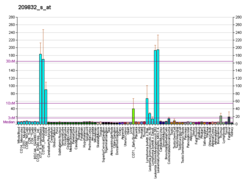DNA replication factor CDT1
Protein found in humans From Wikipedia, the free encyclopedia
CDT1 (Chromatin licensing and DNA replication factor 1) is a protein that in humans is encoded by the CDT1 gene.[5][6][7][8] It is a licensing factor that functions to limit DNA from replicating more than once per cell cycle.
Role in pre-replication complexes
The protein encoded by this gene is a key licensing factor in the assembly of pre-replication complexes (pre-RC), which occurs during the G1 phase of the cell cycle. In the assembly of pre-RCs, origin recognition complexes (ORC1-6) recognize and bind to DNA replication origins. CDT1, along with the protein CDC6, are then recruited to the forming pre-RC, followed by minichromosome maintenance complexes (MCM2-7).[9]
The activity of CDT1 during the cell cycle is tightly regulated during the S phase by the protein geminin, which inhibits it, and by SCFSKP2, which ubiquinates the protein to tag it for proteasomal degradation.[10] This regulation is important in preventing relicensing, thus ensuring that DNA is only replicated once per cell cycle.
Orthologs
CDT1 belongs to a family of replication proteins conserved from yeast to humans. Examples of orthologs in other species include:
- S. pombe – CDT1 (CDC10-dependent transcript 1)[11]
- Drosophila melanogaster – 'double parked' or Dup[12]
- Xenopus laevis - CDT1[13]
Interactions
DNA replication factor CDT1 has been shown to interact with SKP2.[14] Cdt1 is recruited by the origin recognition complex in origin licensing. Null-mutations for CDT1 are lethal in yeast; the spores undergo mitosis without DNA replication. The overexpression of CDT1 causes rereplication in H. sapiens, which activates the Chk1 pathway, preventing entry into mitosis.[15]
References
Further reading
External links
Wikiwand - on
Seamless Wikipedia browsing. On steroids.





